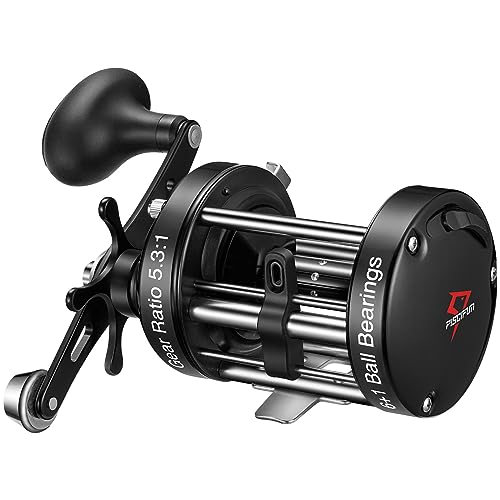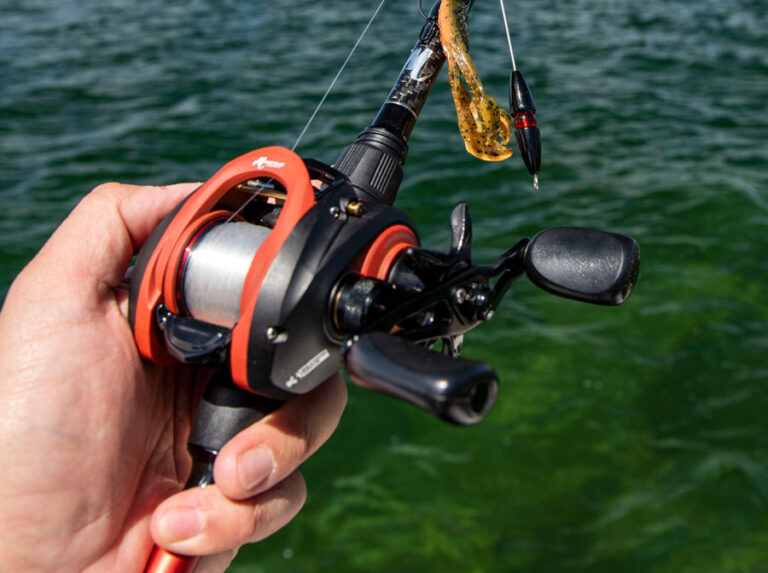Regular maintenance of your baitcasting reel is crucial to ensure optimal performance and longevity. Here are some tips to help keep your reel in top condition.
A baitcasting reel is a crucial piece of equipment for any angler. Maintaining it properly ensures that it will perform at its best and last for many fishing trips to come. Whether you’re a seasoned angler or just starting out, regular upkeep of your baitcasting reel is essential.
In this article, we will provide you with some tips on how to maintain a baitcasting reel to keep it in top shape. From cleaning and lubrication to proper storage, we’ll cover everything you need to know to keep your reel in top condition and help you get the most out of your fishing trips.

Credit: www.amazon.com
Understanding Baitcasting Reels
Baitcasting Reel Maintenance Tips
Baitcasting reels are commonly used by experienced anglers for a variety of fishing practices, including bass fishing, trolling, and deep-sea fishing. Maintaining a baitcasting reel is crucial to ensure its longevity and consistent performance. Here are some helpful tips for maintaining your baitcasting reel.
What Is A Baitcasting Reel And How Does It Differ From Other Types Of Fishing Reels?
A baitcasting reel is a type of fishing reel that is mounted on top of a fishing rod. It has a spool that rotates as the angler casts their line. Unlike spinning reels, baitcasting reels require a certain level of skill to operate efficiently.
Baitcasting reels allow for greater control and accuracy, especially when casting large lures or fishing in heavy cover.
Identifying The Parts Of A Baitcasting Reel And Their Functions
Before delving into maintenance tips, it’s crucial to understand the parts of a baitcasting reel. The following are the essential parts of a baitcasting reel and their functions:
- Spool: The spool is responsible for holding the fishing line.
- Brake system: The brake system controls the speed of the spool rotation.
- Drag system: The drag system is responsible for regulating the tension on the fishing line.
- Handle: The handle is used to turn the spool when reeling in the fishing line.
- Frame: The frame supports the internal components of the reel.
- Level wind system: This system evenly distributes the fishing line on the spool while reeling.
Pros And Cons Of Using A Baitcasting Reel For Fishing
While baitcasting reels offer several advantages over other types of reels, there are also some downsides to using them. Here are some of the pros and cons of using a baitcasting reel:
Pros
- Increased accuracy and control when casting larger lures.
- Ideal for heavy cover fishing and deep-sea fishing.
- Offers better line control and sensitivity.
- Reels in quickly, making it easier to catch fish faster.
Cons
- Baitcasting reels require a certain degree of skill and practice to use.
- The learning curve can be steep.
- They tend to be more expensive than other types of reels.
- The weight and size of the reel can be burdensome for some anglers.
Baitcasting reels offer several benefits but require a certain level of skill and maintenance to operate efficiently. By understanding the essential parts of a baitcasting reel and following basic maintenance tips, anglers can extend the longevity of their reels and improve their overall fishing experience.
Why Maintaining Your Baitcasting Reel Is Essential
Baitcasting reels are an essential tool for every angler, and regular maintenance is crucial for their optimal performance and longevity. Without proper maintenance, your baitcasting reel can wear out quickly, leading to expensive repairs or having to replace it with a new one.
Therefore, here are the key reasons why maintaining your baitcasting reel is essential:
The Importance Of Maintaining Your Baitcasting Reel For Optimal Performance And Longevity
Without regular maintenance, your reel’s performance can deteriorate, and you may struggle with throwing accurate casts or retrieving your bait. To maintain its optimal performance and longevity, here are the best maintenance practices:
- Clean your reel after every use to remove dirt, debris, and saltwater that can cause corrosion and damage.
- Lubricate the moving parts of your reel with oil or grease to reduce friction and increase efficiency.
- Inspect your reel regularly for loose or damaged parts such as screws, handle knobs, and spools.
- Store your reel in a dry and cool place, away from direct sunlight or heat, to prevent damage and rust.
How Neglecting Regular Maintenance Can Lead To Costly Repairs And Replacements
If you neglect regular maintenance of your baitcasting reel, it may lead to significant damages, and you may have to repair or replace it sooner than expected. Here are some problems that can arise from poor maintenance, and how you can avoid them:
- Corrosion: Saltwater, grime, and dirt can accumulate on your reel’s surface and lead to corrosion of metal parts, causing damage and deterioration of its performance.
- Malfunction: Dirt and debris can cause malfunctioning of your reel’s moving parts and prevent it from working correctly.
- Reduced accuracy and distance: Over time, your reel’s line guide and spool may wear out, reducing your casting accuracy and distance.
To avoid these problems, maintain your reel regularly by cleaning, lubricating, and inspecting it after every use.
Common Problems That Can Arise From Poor Maintenance And How To Avoid Them
Maintaining your baitcasting reel involves a few essential practices and regular checkups to ensure its optimal performance and longevity. Here are the best ways to avoid common problems that can arise from poor maintenance:
- Clean your reel with freshwater after every use, especially if you use it in saltwater.
- Lubricate the reel’s moving parts with oil or grease to reduce friction and increase efficiency.
- Inspect your reel regularly for loose or damaged parts, screws, handle knobs, and spools.
- Store your reel in a dry and cool place, away from direct sunlight or heat, to prevent damage and rust.
By properly maintaining your baitcasting reel, you can enjoy its optimal performance and longevity, making your fishing experience smooth and successful.
Conclusion
Maintaining your baitcasting reel is essential to prolong its life and optimize its performance. By following these maintenance tips, you can keep your reel in top condition and enjoy an efficient and enjoyable fishing experience. Regular cleaning and lubrication of the reel’s components, checking for wear and tear, and adjusting the brakes and spool tension will prevent issues and damage in the long run.
Additionally, you can save money on repairs or replacements and spend more time fishing. Remember to store your reel in a dry and cool area, away from direct sunlight or moisture. By taking care of your baitcasting reel, you can keep it like new and have a successful fishing trip every time.
Thank you for reading, and happy fishing!




